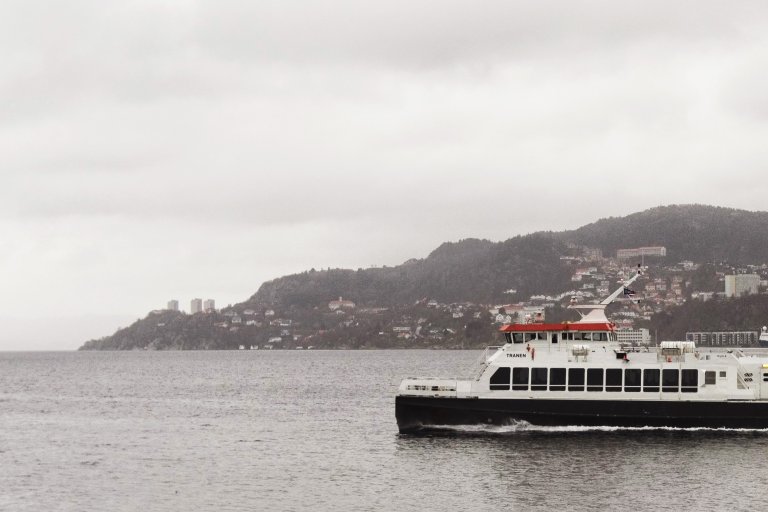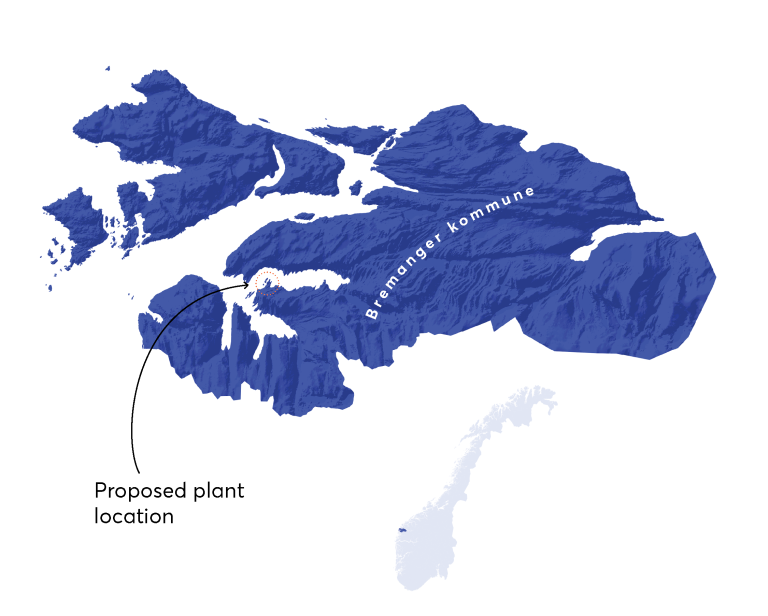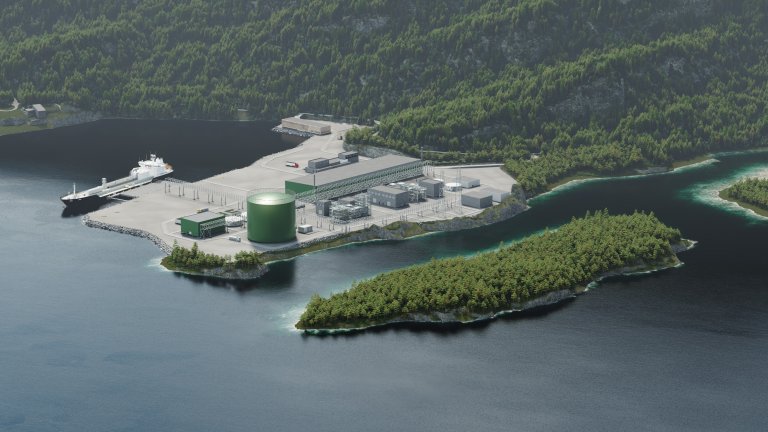Hydrogen-powered high-speed ferries reduce emissions, provided the hydrogen is produced using renewable energy. Foto: Eilif Ursin Reed
Hydrogen production is gaining attention in Norway
Shipping and heavy transport must reduce emissions. Hydrogen and ammonia are emerging as potential alternative fuels. The EU is optimistic, but is this a sustainable solution for the future?
"Hydrogen plays a key role in the EU's plan to reduce emissions," says Merethe Dotterud Leiren, CICERO researcher and expert on European climate and energy policy.
She explains that the EU plans to use hydrogen as a fuel for sectors that are difficult to electrify, such as industry, shipping, and aviation. It can also serve as a means of energy storage during periods of surplus production, for example, when strong winds produce more wind power than is immediately needed.
When hydrogen is burned or converted into electricity in a fuel cell, the only emission is water. However, it remains emission-free only if production is based on green energy.
"While hydrogen has traditionally been produced from fossil fuels, the EU is now placing a strong focus on renewable hydrogen," says Leiren.
Hydrogen is produced through a chemical process known as electrolysis, where hydrogen atoms are separated from water. This energy-intensive process requires significant electricity, but when powered by renewable energy sources, the resulting hydrogen can be classified as green.
In response to Russia's invasion of Ukraine and the ensuing energy crisis, the EU launched the RePowerEU plan, aimed at securing energy independence while accelerating the transition to a greener economy.
"Part of this plan is to produce at least 10 million tons of green hydrogen domestically by 2030 and import an additional 10 million tons. This effectively doubled the EU's hydrogen ambitions," she says.
Achieving such a large supply of green hydrogen will demand vast amounts of renewable energy, highlighting the critical need for rapid scaling of green energy infrastructure.
"If the EU does not have sufficient renewable energy, they have indicated that a transitional period with gray hydrogen—produced from natural gas —may be permitted, as green hydrogen production is still in its early development stages," she says.
Zero-emission high-speed ferries
Clean and efficient, emitting only water? Is it as simple as setting sail? CICERO has conducted a lifecycle analysis of green hydrogen for high-speed ferries in Norway to evaluate whether replacing diesel with hydrogen delivers significant climate benefits. The study accounts for all emissions associated with both production and use.

"Hydrogen production requires a significant amount of electricity, and even with renewable energy, upstream emissions from infrastructure and production mean the electricity will have a certain carbon footprint. Additionally, hydrogen leaks may occur, which could contribute to indirect warming. However, the overall results show that hydrogen-powered high-speed ferries reduce emissions, provided the hydrogen is produced using renewable energy," says Emil Dæhlin, a CICERO advisor who contributed to the analysis.
Dæhlin explains that high-speed ferries consume significant amounts of energy, with many routes spanning long distances and allowing limited docking time. This makes battery-electric operation impractical for a number of routes, as there isn’t sufficient time to recharge the batteries. As a result, these ferries are well-suited to hydrogen as an alternative fuel.
At the same time, they are small and space-constrained. Compressed hydrogen must be stored under pressure in tanks that take up significant space. This presents a drawback, as the storage of expensive fuel reduces the space available for paying passengers.
"Space is a challenge. That’s why liquid hydrogen, which requires less storage space, could be a viable alternative, although it demands more energy to produce. Another challenge, for both liquid and compressed hydrogen, is that new vessels with updated propulsion systems would need to be built," explains Dæhlin.
In other words, transitioning to hydrogen-powered high-speed ferries for routes like Florø to Bremanger on the Norwegian west coast is a complex undertaking.
The factory planned in Bremanger will consume equivalent to roughly one-third of Oslo's total electricity use
Ammonia as an Alternative Fuel?
If you were to dock in Bremanger, you’d find the local population actively discussing an alternative to hydrogen-powered shipping.
Plans are underway to establish a facility for ammonia production in the area.
Ammonia is a colorless gas with a high hydrogen content, making it a promising energy carrier and fuel, particularly for ships. It can be transported by tankers and stored in tanks, similar to gasoline and diesel today. When burned, its emissions are primarily water and nitrogen, though nitrogen oxide (NOx) emissions may occur without proper controls.
"The gas can be cooled to a liquid state, allowing it to use existing storage and distribution facilities with fewer modifications than hydrogen," explains CICERO researcher and economist Asbjørn Torvanger, who hails from Bremanger.


However, producing ammonia still requires hydrogen, meaning the high energy demand remains unavoidable.
"The factory planned in Bremanger will consume equivalent to roughly one-third of Oslo's total electricity use," says Torvanger, underscoring the scale of the project.
The project is supported with over 200 million euros from the EU’s Innovation Fund. The planned ammonia factory is led by an Australian company, which chose Bremanger for its abundant access to renewable energy.
Hydropower will make the energy-intensive ammonia production process emission-free. However, ammonia production won’t be the only energy-demanding industry in the municipality. Nearby is Elkem Bremanger, a facility producing ferrosilicon products, which also was established in Bremanger due to its abundant and affordable hydropower resources.
It has been there for over a hundred years and employs around 200 people. Now they fear competition for electricity and rising costs.
"An ammonia factory in Bremanger will inevitably drive up electricity prices in the relevant price area. This is due to Norway’s market-based electricity system, which is governed by supply and demand. However, it’s difficult to predict the exact extent," says Torvanger.
Environmental disruption, concerns over toxic ammonia leaks, rising electricity prices, and fears of job losses at Elkem Bremanger have ignited a heated debate among residents in the Western Norwegian municipality. Multiple public meetings have been held, and the local newspaper has featured a flurry of opinion pieces. The company behind the facility, Fortescue, has countered in one article, addressing what they see as misinformation and exaggerated concerns about the ammonia plant.
Risk
Torvanger believes there is a risk associated with developing ammonia factories, such as the one being discussed in Bremanger.
"The EU aims to create a market for ammonia, but it has not been established yet. Norwegian hydropower is attractive for production, but it carries a risk. There is no guarantee that a large market willing to pay profitable prices will emerge," says Torvanger.

If the market never materializes, we risk ending up with large ammonia factories that we don’t need. In the process, Norwegian municipalities may have invested resources—and, critically, land and electricity—into a solution that failed to materialize.
"Today, ammonia is far more expensive than diesel. No one will use ammonia out of goodwill; it has to be profitable. Ammonia must become cheaper to use, and emitting CO₂ must become more expensive," says Torvanger.
Torvanger also emphasizes that Norway’s hydropower and wind power are valuable resources that should be strategically managed to maximize their benefits.
"We need to discuss how to allocate electricity to create the greatest possible value," says Torvanger.
The ammonia factory in Bremanger is expected to create 35–70 jobs.
"There are other ways to utilize electricity that can also contribute to reducing emissions," Torvanger adds, pointing to the importance of prioritizing high-impact applications.
He points out that although data centers are controversial—due to their high electricity consumption and limited job creation—they are an established and growing industry with financially committed players. This makes their revenues more predictable and secure.
Steady Climate Course in the EU
"The EU will need alternative fuels and methods for energy storage. That’s why they are investing heavily in creating a market for green hydrogen. Success is uncertain, as all new technologies carry risk. However, failing to act carries its own significant risks," says Leiren.
Leiren believes the EU will remain committed to its climate course, despite facing challenges in implementing many of its policies.
"The EU has consistently responded to crises with stronger climate policies and a reinforced green agenda, whether during COVID-19 or the energy crisis caused by Russia's invasion of Ukraine," says Leiren.
Climate policy is about energy security, industry, and jobs; it’s about survival in a world shaped by pragmatic political realities and shifts in global trade. But it’s also about the EU recognizing that cutting greenhouse gas emissions serves its own self-interest.
"Europe is experiencing the impacts of climate change firsthand. Floods, droughts, and heatwaves are already leading to widespread health problems and costing billions in damages each year," says Leiren.
Leiren notes that the 2024 European elections consolidated centrist power, despite gains by populist right-wing parties campaigning to weaken the EU’s climate policies. Ursula von der Leyen, who introduced the European Green Deal in 2019, was re-elected as President of the European Commission.
A vocal advocate for climate policy, von der Leyen continues to prioritize ambitious measures.
Currently, a key part of this agenda is the effort to establish a market for hydrogen—a development making waves from Brussels to Bremanger.
